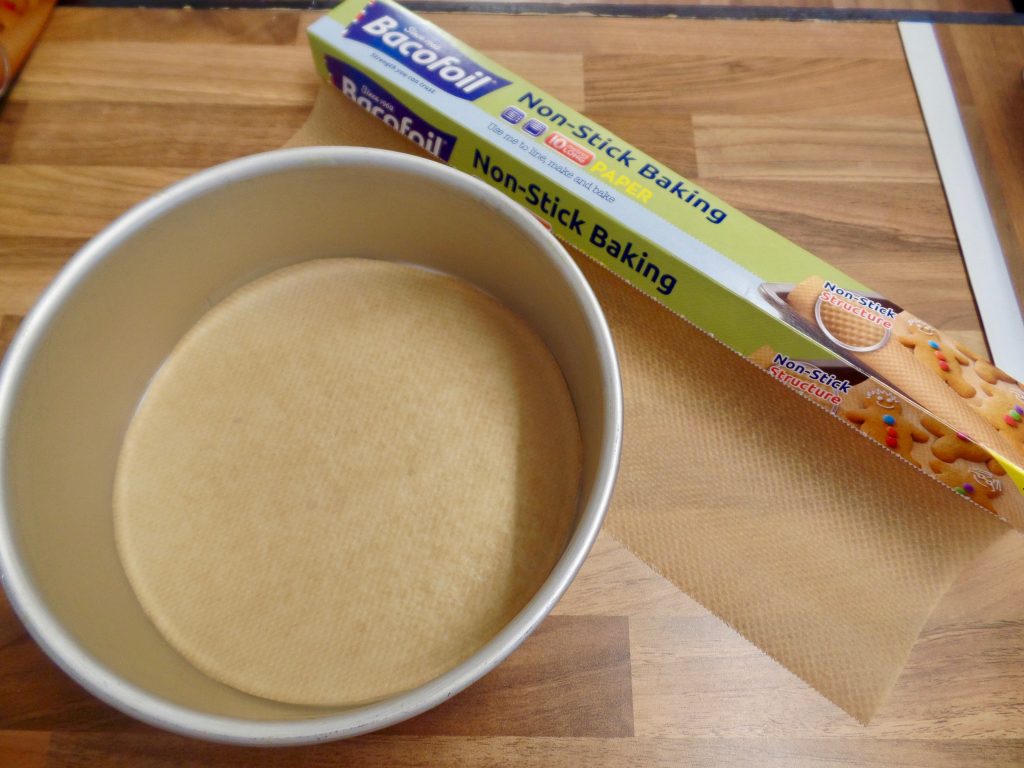A classic birthday cake will have a few elements to it. A soft vanilla sponge, tart seedless raspberry jam, smooth vanilla buttercream and a layer of sugarpaste (ready to roll icing).
Contrary to popular belief, most birthday cakes aren’t a ‘Victoria sponge’. A Victoria sponge is a soft light sponge, baked in two sandwich tins then put together with jam and fresh cream. Lovely for an afternoon tea, but doesn’t lend itself well to be covered in sugarpaste (ready to roll icing). For this, you are better off using a madeira recipe. It’s close textured and firm, whilst still being light and soft to eat. The inclusion of plain flour makes it stronger and better for decorating.
It’s also perfect for carving cakes too, although if you are carving, I recommend popping the cake in the freezer for about 15-20 minutes before starting work. This will reduce crumbs and make your life a lot easier! For more about freezing cakes, click here.
Below is my 7″ round (my most popular size of birthday cake ordered) vanilla madeira recipe and vanilla buttercream recipe. It also is perfect to make 12 cupcakes, for more on cupcakes click here. Make sure all of your ingredients are room temperature as this will help make a better bake! I also recommend lining your tins. I bake one deep cake and use a cake leveller to cut my cake into there sections (see lemon cake below) as opposed to using individual tins, however, this recipe can be used in sandwich tins, just lower the baking time to 35-40 minutes. I use 3″ deep PME tins that are seamless tins made from professional quality anodised aluminium.
If the cake isn’t baked fully when you cut into it, or it’s squidgy in any way, it needed longer in the oven. Ever oven is different and these timings are an approximation. If in doubt, leave it in a further 10 minutes. Due to the low temperature it won’t dry the cake out and will ensure it’s fully baked. The cake needs to spring back to the touch, be golden brown and a skewer come out clean. This will come with experience, the more you bake, the more you’ll know a fully baked cake on sight.
Should you wish to scale the recipe up or down, a number of helpful charts to work this out are easy to find with a quick google. The convertor on CakeFlix is great and they also have a handy app. I also like this one found on The Pink Whisk or you can use the water trick I explain here.
To make the cute owl toppers in the above picture, check out my tutorial here.
For more information on how to decorate your cake and go from home bake to showstopper, check out my list of latest online cake decorating courses here.

Vanilla Madeira Cake Recipe
- 200g self raising flour
- 200g caster sugar
- 200g Stork/butter
- 50g plain flour
- 4 medium eggs
- 1 tsp vanilla
- Cream together the Stork and caster sugar.
- Add in your eggs and mix.
- Add in your flour and mix.
- Add the vanilla and mix again.
- Mix the whole thing for 2-4 minutes on a high speed.
- Pour mixture into a greaseproof paper lined, 7″ cake tin.
- Bake at 140C (fan assisted) for 1 hour 40 minutes or until a skewer comes out clean, the cake is golden brown and springs back to the touch. (Check after 1 hour)
- Once baked, after 5 minutes on the side, turn out onto a sheet of greaseproof paper and leave upside down to cool. This ensures a nice flat top.
- Once cooled, wrap in clingfilm overnight to ‘settle’.
- Once split, filled and iced, this cake will last 7-10 days and will freeze well for 3 months.
NOTE: This recipe is for a 7″ round tin. It is not enough mixture for bigger tin sizes. For this, you will need to convert the recipe here.
For a chocolate madeira;
Follow the recipe above and replace the plain flour for cocoa powder and add 100g melted dark chocolate. For chocolate buttercream, follow the recipe below and add two tablespoons cocoa powder and 50g melted dark chocolate.
For a lemon madeira;
Follow the recipe above and add the zest of one lemon plus two teaspoons of lemon extract. For lemon buttercream, follow the recipe below and add two teaspoons of lemon extract and the zest of one lemon.
Vanilla Buttercream Recipe
- 250g unsalted butter
- 500g icing sugar
- 1 tsp vanilla
- Cream the butter on it’s own for a few minutes.
- Add icing sugar.
- Add vanilla.
You can watch me bake this cake in real time on my Facebook page here; PART 1. PART 2.
Give it a go and let me know how you get on, either on Facebook or Twitter or Instagram.
For more information on how to decorate your cake and go from home bake to showstopper, check out my list of latest online cake decorating courses here.
If you want to turn your baking hobby into a career, check out my book Cakes, Bakes & Business for everything you need to know about running a successful baking business, including pricing, marketing, insurance and much more!
Happy baking!
Britt xo

Topped with Scrumptious Sprinkles Lemon Crunch & Lemon Jelly Squares! I LOVE them!! xo


















